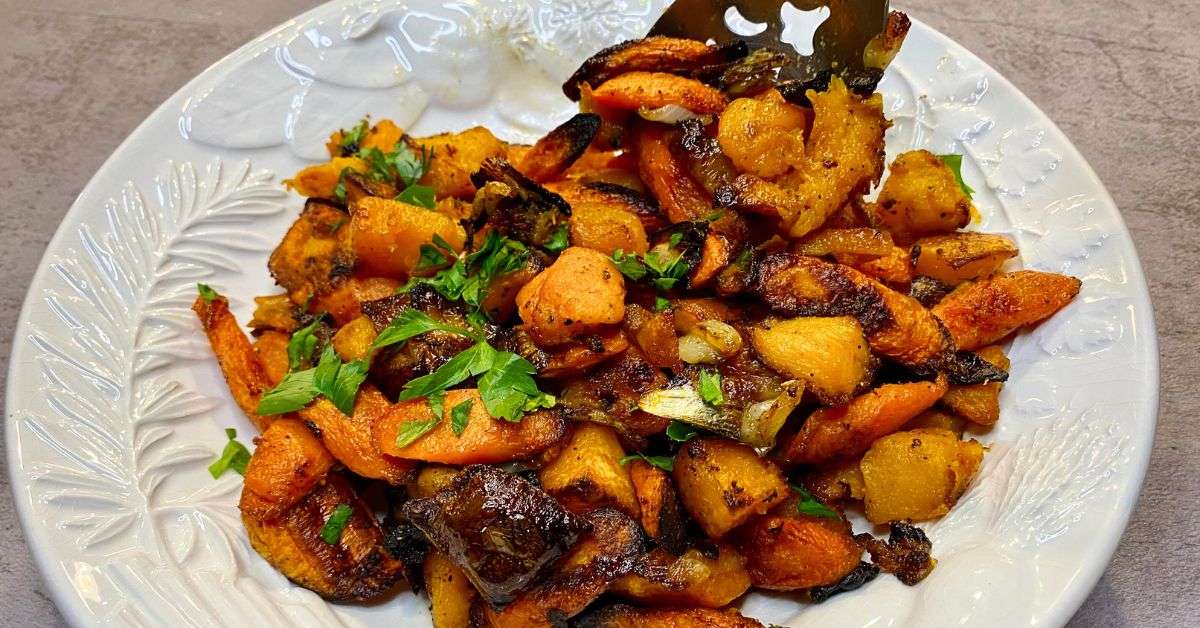Holiday time, or any time for that matter, is a great time to prepare roasted root veggies to have alongside your main dish. Comfort food at its best, you can never go wrong with this combination. Grab a fork and let’s dig in 🙂
My favorite roasted root veggies combinations? I love to combine cubes of butternut squash with thick slices of carrots and chunks of sweet Vidalia onion. A little Extra virgin olive oil, garlic salt, onion powder and fresh cracked black pepper round out the taste and deliver a deliciously savory sweet side dish. Sometimes, I also throw in quartered baby potatoes which also complement the other veggies. Roasted all together, the sugars from the root veggies all caramelize and create this amazingly addictive combination of flavors. Drizzle some syrupy balsamic vinegar, and top with some Maldon finishing salt and wow, I could eat this all day!
In This Post: Everything You will need to make Roasted root veggies
- Equipment you will need
- Ingredients you will need
- All About balsamic vinegar of Modena
- How to make this recipe
- Frequently Asked Questions
- Rebecca’s Tips for Success
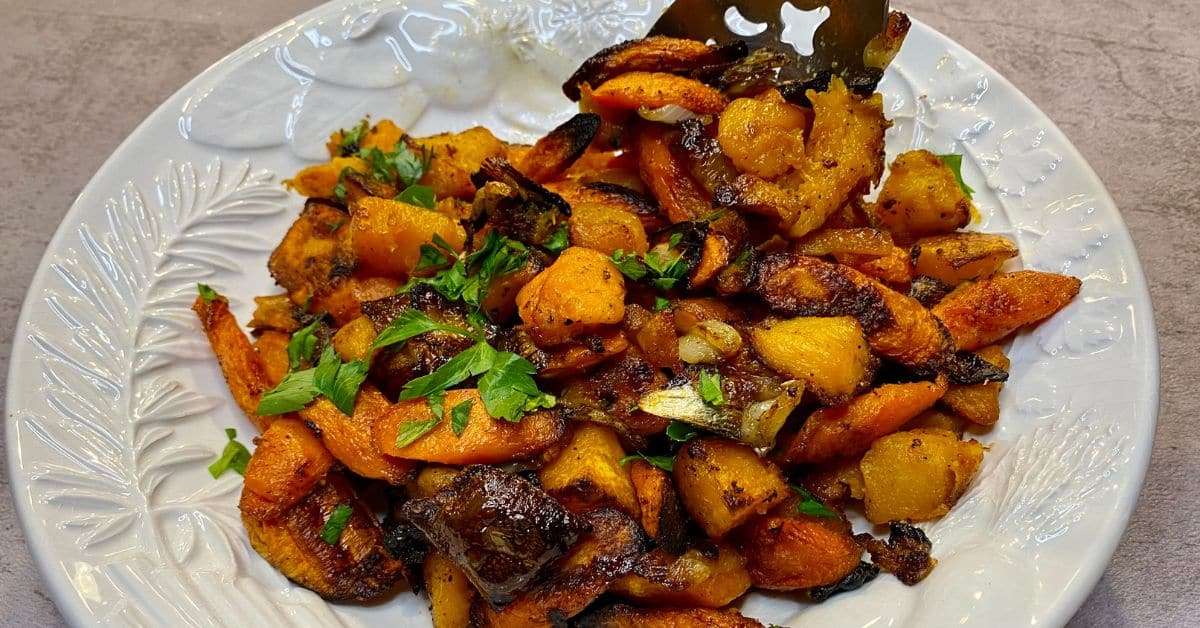
Equipment You Will Need:
- large sheet pan
- aluminum foil
- chef’s knife
- cutting board
- veggie peeler
- large mixing bowl
- rubber spatula
- metal spatula
- measuring spoons
- liquid measuring cup
Ingredients You Will Need to make roasted root veggies:
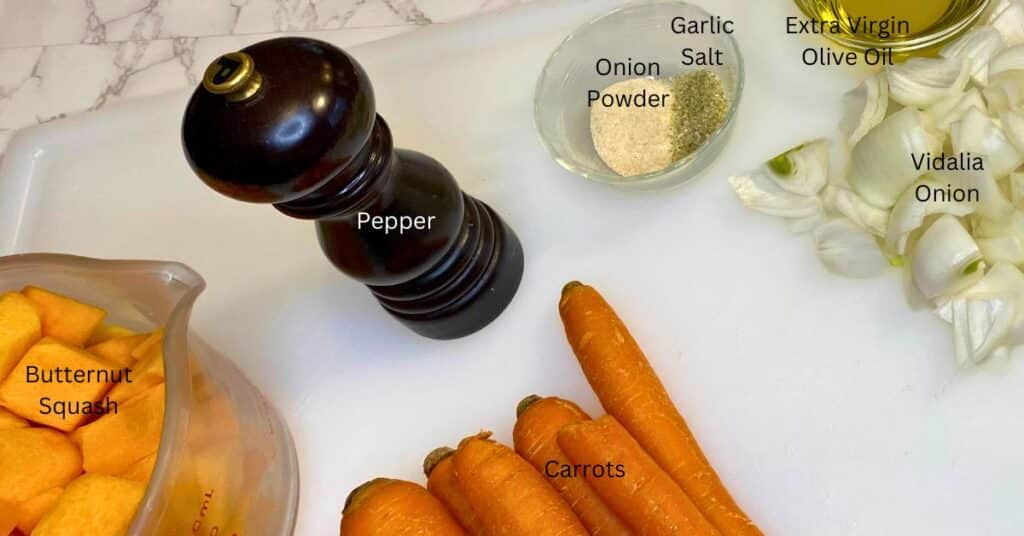
- carrots, peeled and sliced on the bias (diagonally)
- butternut squash, cut in cubes (purchase already prepped cubes as it saves a ton of time!)
- Vidalia onion, peeled, cut in half, then cut into large pieces
- baby potatoes, cut in quarters (optional, but will be a more filling side dish)
- garlic salt
- onion powder
- freshly ground pepper
- Extra Virgin olive oil or Avocado oil
***Pro Tip: Avocado oil is one of the best choices for roasting at high temperatures, as the smoke point is 520 deg. F, meaning it will withstand heat up to this temperature without burning or breaking down. I like to use 1/4 to half EVOO for the taste, and the remainder Avocado. Plus, they are both heart-healthy choices when used in moderation, and easily digestible. I made this change years ago whenever roasting at high temperatures.
After Roasting:
- balsamic vinegar – the thicker, syrupy kind (for drizzling once roasted)
- flaky finishing salt – I like Maldon brand – optional but helps balance the flavors. (Side note – this type of salt can also be sprinkled on to baked goods such as brownies when coming right out of the oven to take your brownies to the next level!)
- flat leaf Italian parsley (garnish)
All About Balsamic Vinegar of modena:
What is Balsamic Vinegar of Modena?
This type of balsamic vinegar is a renowned Italian vinegar, celebrated for its rich, complex flavor. Originating from the Modena region in northern Italy, it is made by cooking freshly harvested grape must (juice, seeds, and skins) and fermenting it. Over time, the vinegar ages in wooden barrels, which imparts unique flavors from the wood, such as oak, chestnut, or cherry.
During the fall of 2023, my husband and I were fortunate enough to visit Italy and ventured to Bologna on a day trip. Of course, we needed to purchase some of this coveted balsamic vinegar and found a local company store who sold their own brand. Sooo delicious!! After sampling several different aged types, we settled on an assortment of their best vinegars that I could incorporate into my recipes. The bottle you see me using in this recipe comes from the same shop. To find out more about how their vinegar is produced, click here.
How is Balsamic Vinegar of Modena Produced?
The traditional Balsamic Vinegar of Modena undergoes a meticulous aging process, which can range from a few months to several years. As it ages, the vinegar becomes thicker, sweeter, and less acidic. This results in a syrupy texture and a perfect balance of sweet and tangy notes. Don’t confuse Balsamic Vinegar of Modena with commercial versions which are lighter and more acidic. These mass-produced options often mix grape must with wine vinegar and caramel coloring, making them more affordable but less complex.
For the highest quality, look for PDO (Protected Designation of Origin) or PGI (Protected Geographical Indication) labels, which guarantee the vinegar’s authenticity and adherence to traditional methods.
How do you incorporate this type of vinegar into your recipes?
You can use Balsamic Vinegar of Modena in a variety of ways. For example, it enhances salads, roasted veggies like this recipe, grilled meats, and cheeses. Include it on a charcuterie board to add another flavor dimension. Additionally, it adds depth to marinades and sauces and pairs wonderfully with fruits like strawberries or pears, and even desserts such as gelato or drizzled over chocolate.
Ok, so now after talking about all this, I’m really hungry….so let’s get right to making these roasted veggies!
How to make this Roasted Root veggies recipe:
First
- Peel 5-6 large carrots and slice on a bias (diagonally)

- Open 1 lb. package pre-cut butternut squash (I highly recommend the pre-cut as it saves a ton of effort), but if you can’t find any, peel a large butternut squash and cut in half, scoop out seeds, and cut into small cubes
- Peel Vidalia onion, slice in half, place on flat side and slice each half in half, then cut into large chunks

- Remove leaves from parsley, and chop medium

- If adding baby potatoes (optional), cut into quarters, rinse in a bowl of water, drain and pat dry. This removes excess starch and helps the potatoes to brown and become crispy.
- Add all veggies to a large bowl and mix together
Second
- To the bowl of veggies, add 1/4 cup extra virgin olive oil (or avocado or a mixture of each, your choice), 1 tsp. garlic salt, and 1 tsp. onion powder (or onion granules – I find that it doesn’t clump as much when left in the jar as does the powder), and freshly ground black pepper.

Third
- Mix everything together, making sure that all veggies are covered with oil and seasonings.
Next
- Preheat oven to convection bake at 425 deg. F, or regular bake at 450 deg. F
- Line a large sheet pan with heavy duty aluminum foil, (saves on cleanup).
- Transfer veggies on to a rimmed sheet pan and place in preheated oven.
- Set timer for 20 minutes, flip veggies, and continue to roast until veggies are golden brown with caramelized edges, about 20-25 minutes longer.
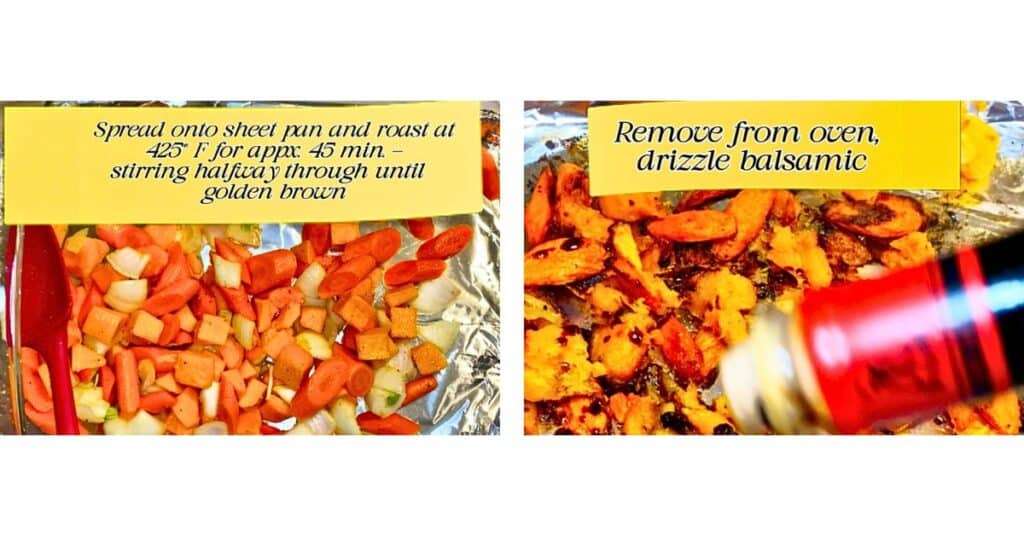
Finally
- Remove from oven and drizzle with syrupy balsamic vinegar.
- Transfer into serving bowl and sprinkle with finishing salt (like Maldon salt) and parsley, and serve immediately.
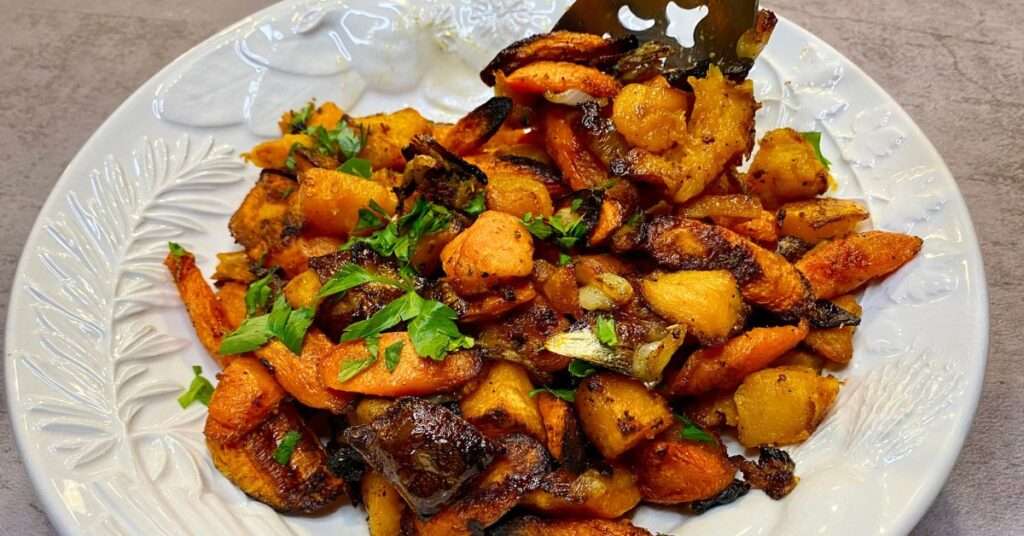
Enjoy your roasted veggies!!
Frequently Asked Questions about roasting root veggies:
What are the best root vegetables to roast?
The best root vegetables for roasting include carrots, potatoes, sweet potatoes, parsnips, beets, and turnips. These vegetables are rich in starch, which makes them perfect for roasting as they become crispy on the outside and tender on the inside.
How long do root vegetables take to roast?
Roasting time varies depending on the type and size of the root vegetable. Most root vegetables take about 25-45 minutes. For example, potatoes and carrots take around 30-40 minutes, while beets may need 45 minutes or more. Be sure to check them halfway through and stir occasionally to ensure even cooking.
How do I make root vegetables crispy when roasting?
To make root vegetables crispy, make sure to coat them evenly with oil before roasting. Additionally, avoid overcrowding the pan, as this can cause steaming rather than roasting. Instead, spread the vegetables in a single layer and turn them halfway through cooking.
Should I peel root vegetables before roasting?
Peeling root vegetables is optional. For most vegetables, like carrots and sweet potatoes, you can leave the skin on to add extra texture and nutrients. However, if the skins are tough or you prefer a smoother texture, peeling may be the best option. This is my preferred option.
What is the best type of oil to use for roasting root vegetables?
Both olive oil and avocado oil are popular choices for roasting veggies because of their flavor and health benefits. Since avocado oil has a high smoke point (520 deg. F) it makes a great choice for roasting. Choose one that suits your taste and the roasting temperature. I like to mix half EVOO and avocado for nice flavor.
Rebecca’s Tips For Success:
- Cut the Veggies Evenly for Consistent Cooking – First, ensure that all your vegetables are cut into uniform pieces. This step is crucial because evenly sized pieces will cook at the same rate, preventing some from being undercooked while others are overcooked.
- Preheat Your Oven – Always preheat your oven before putting your vegetables inside. This ensures they begin cooking immediately and helps them become crispy and caramelized.
- Avoid Overcrowding the Pan – Give your vegetables space to roast properly by arranging them in a single layer on the baking sheet. Overcrowding traps steam, preventing the vegetables from becoming crisp. I often have to use two baking sheets for more room.
- Flip Halfway Through Cooking – To ensure even roasting, flip your vegetables halfway through the cooking time. This allows both sides to become golden brown and crispy, enhancing texture and flavor.
- Rinse Potatoes and Pat Dry – If using potatoes, after cutting them, place in a bowl of cold water to remove excess starch. Then, drain and pat dry. By removing excess starch it helps to ensure the potatoes cook up crispy.
Looking for other roasted root veggies recipes? Try my delicious roasted butternut squash!
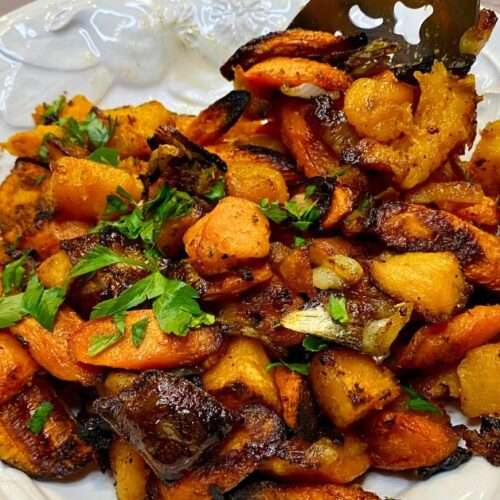
Roasted Root Veggies – Easy, Sweet & Savory
Equipment
- aluminum foil
- large mixing bowl
Ingredients
- 6 large carrots (peeled, and cut on a bias in 1/2" thickness)
- 1 large Vidalia onion (cut in halves, then cut again and cut into large chunks)
- 16 oz. butternut squash cubes (or 1 large, peeled, seeded and cut into cubes)
- 8 baby potatoes (cut into quarters (optional))
- ¼ cup Extra Virgin olive oil (or a mixture of both EVOO and avocado oils)
- 1 tsp. garlic salt
- 1 tsp. onion powder
- freshly ground black pepper
- balsamic vinegar (the syrupy kind – see "About Balsamic Vinegar")
- flaky salt (finishing salt like Madon, optional, but makes the flavors "pop")
- 2 Tbsp. flat leaf parsley (chopped – for garnish)
Instructions
Preheat oven to Convection bake at 425 °F or Regular bake 450 °F
- Line a large sheet pan with heavy duty aluminum foil (saves on cleanup) and set aside.
- Peel 6 large carrots and slice on a bias (diagonally) into ¼ to ½" width
- Open 16 oz. butternut squash cubes, pre-cut (I highly recommend the pre-cut as it saves a ton of effort), but if you can't find any, peel a large butternut squash and cut in half, scoop out seeds, and cut into small cubes.
- Peel 1 large Vidalia onion, slice in half, place on flat side and slice each half in half, then cut into large chunks
- Remove leaves from parsley, and chop medium.
- If adding baby potatoes (optional), cut 8 baby potatoes into quarters, rinse in a bowl of water, drain and pat dry. This removes excess starch and helps the potatoes to brown and become crispy.
- Add all veggies to a large bowl and mix together. Then, add ¼ cup Extra Virgin olive oil (or avocado or a mixture of each, your choice), 1 tsp. garlic salt, and 1 tsp. onion powder (or onion granules – I find that it doesn't clump as much when left in the jar as does the powder), and freshly ground black pepper to taste.
- Mix everything together, making sure that all veggies are covered with oil and seasonings, and transfer veggies onto a rimmed sheet pan and place in the preheated oven on middle rack.
- Set timer for 20 minutes, flip veggies, and continue roasting for about 25 more minutes. Continue to roast until veggies are golden brown with caramelized edges.
- Remove from oven and drizzle with syrupy balsamic vinegar and mix to distribute. Sprinkle with finishing flaky salt (like Maldon salt), and transfer to a serving bowl. Garnish with 2 Tbsp. flat leaf parsley serve immediately & Enjoy!
Notes
- Cut the Veggies Evenly for Consistent Cooking – First, ensure that all your vegetables are cut into uniform pieces. This step is crucial because evenly sized pieces will cook at the same rate, preventing some from being undercooked while others are overcooked.
- Preheat Your Oven – Always preheat your oven before putting your vegetables inside. This ensures they begin cooking immediately and helps them become crispy and caramelized.
- Avoid Overcrowding the Pan – Give your vegetables space to roast properly by arranging them in a single layer on the baking sheet. Overcrowding traps steam, preventing the vegetables from becoming crisp. I often have to use two baking sheets for more room.
- Flip Halfway Through Cooking – To ensure even roasting, flip your vegetables halfway through the cooking time. This allows both sides to become golden brown and crispy, enhancing texture and flavor.
- Rinse Potatoes and Pat Dry – If using potatoes, after cutting them, place in a bowl of cold water to remove excess starch. Then, drain and pat dry. By removing excess starch it helps to ensure the potatoes cook up crispy.
YOUR OWN NOTES
Nutrition
Disclosure
The provided nutritional information should only be used as a general guideline rather than an exact representation of the nutritional content of the prepared dish. Individual nutritional needs and dietary preferences may vary, and we encourage our readers to use their discretion and consult with a qualified healthcare professional or nutritionist for personalized dietary advice.

